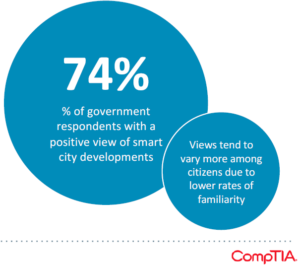Contributor: Robert Forget, CTO, Aware360 and Vice Chair of Smart Cities Advisory Council, CompTIA
The “how do you eat an elephant?” question is surprisingly accurate when it comes to Smart Cities initiatives. The answer, of course, is “one bite at a time.” At the CompTIA ChannelCon 2018 event in Washington D.C. in early August, we discussed what these bites will require, from the skills necessary to plan to the talent for implementation. It was my third meeting as the Vice Chair of the Smart Cities Advisory Council, and it rounded off nine months of discussions on various aspects of Smart Cities (or Smart Communities).
This year, I was reminded that no single entity can successfully be an expert in all the skills and technologies required for Smart Cities. An ecosystem of partners must work together to tackle the unique challenges.
Going from digital to smart requires redesigning foundations, not just adding apps
Digital transformation in communities is nearly complete and very mature across the industry. Because of this maturity, we have cities and municipalities with a good grasp of technology that have successfully migrated to a digital-first mentality over the last two decades.
Becoming a smart community, however, requires a broader approach. CompTIA’s research report on Building Smarter Cities and Communities summarizes the challenge:
“Making the leap from digital to smart requires advances on many fronts. Most municipalities are on the digital continuum, meaning some level of e-government services are provided to citizens or technology used in an operational capacity. To make the leap from digital to smart, however, requires more than deploying a new mobile app and a few sensors. Rather, it typically requires a re-thinking of everything from IT architecture and broadband infrastructure, to workflows, user experience (UX), staff training and more. Smart cities must be built on smart foundations.”
Citizen and government concerns such as ROI offer opportunities for vendors
CompTIA research suggests that three-quarters of governments have a positive view of smart city developments, but citizens’ views vary because they lack familiarity with the issue.

Engaging citizens in the foundation for Smart Cities will be critical, since they are the end customers who should benefit from projects being launched. The CompTIA Smart Cities research paper solicited input from the voice of the customer, and the concerns of government and citizens were similar:

Vendors and solution providers should pay close attention to these lists. These are real concerns and potential causes of failure in any planned projects. They also reveal opportunities. For instance, one important concern is insufficient ROI. If vendors provide proof of ROI before the launch of an initiative, they can eliminate the funding / budget concern up front. There are also various ways to fund Smart Cities initiatives outside of citizen taxes. The industry and government should work closely to review options for grant funding, public/private partnerships, and success-based funding options to better meet the expectations of citizens while advancing the implementation of innovative technologies.
Innovative technologies need to come together as a solution set
The technology opportunities themselves are plentiful. The global IT market is estimated at US$4.8 trillion in 2018. Unemployment in the sector is at 1.9%, much lower than overall rates. Smart Cities are already contributing to this number. MarketandMarkets estimates the worldwide Smart Cities market to grow from $425 billion in 2017 to $1.2 trillion by 2022. The core Global IT market is also growing with the use and deployment of new emerging technologies. CompTIA identifies the top 10:
1. Internet of Things (IoT)
2. Automation
3. Artificial Intelligence (AI)
4. AR/VR
5. 5G
6. 3D Printing
7. Drones
8. Biometrics
9. Blockchain
10. Quantum Computing
Smart Cities incorporates and can leverage many of these emerging tech categories, including IoT, Automation, AI, 5G, Drones and Biometrics. With any use of emerging technologies, the goal is repeatability and the ability to successfully implement and operate a deployed solution. A Smart Cities deployment is not just a technology – it is a use case and overarching solution set.
Beyond technology, the required skills must come from partners working together
Successfully planning, implementing and operating a Smart Cities solution requires a variety of skills. The Smart Cities Advisory Council documented them earlier this year:
1. IoT Solutions Architecture
2. AI and Machine Learning
3. Wireless Connectivity for IoT
4. Understanding Hardware (Sensors, Devices, Gateways…)
5. Edge Computing
6. Network Management
7. Implementation and Integration
8. Project Management
9. Change Management
10. Operations and Maintenance
11. Compliance
12. Cybersecurity
13. Community Interface
14. Big Data
15. IoT Clouds (Stream Processing and APIs)
16. Business Case Development
17. Soft Skills and Design Thinking
This brings us back to the title of this post. No single entity can master every required skill. We as the vendor community need to work together, each bringing our expertise to create a consistent experience and ensure a better outcome for the end customer.
When we do, we can bring a brighter future and help build successful use cases for Smart Cities. There is a lot of technology and more than enough money to share across this new and exciting landscape. It is more important to hit the desired outcomes together than to fail alone.
"Coming together is a beginning. Keeping together is progress. Working together is success." --Henry Ford